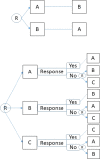Application of Bayesian methods to accelerate rare disease drug development: scopes and hurdles
- PMID: 35526036
- PMCID: PMC9077995
- DOI: 10.1186/s13023-022-02342-5
Application of Bayesian methods to accelerate rare disease drug development: scopes and hurdles
Abstract
Background: Design and analysis of clinical trials for rare and ultra-rare disease pose unique challenges to the practitioners. Meeting conventional power requirements is infeasible for diseases where sample sizes are inherently very small. Moreover, rare disease populations are generally heterogeneous and widely dispersed, which complicates study enrollment and design. Leveraging all available information in rare and ultra-rare disease trials can improve both drug development and informed decision-making processes.
Main text: Bayesian statistics provides a formal framework for combining all relevant information at all stages of the clinical trial, including trial design, execution, and analysis. This manuscript provides an overview of different Bayesian methods applicable to clinical trials in rare disease. We present real or hypothetical case studies that address the key needs of rare disease drug development highlighting several specific Bayesian examples of clinical trials. Advantages and hurdles of these approaches are discussed in detail. In addition, we emphasize the practical and regulatory aspects in the context of real-life applications.
Conclusion: The use of innovative trial designs such as master protocols and complex adaptive designs in conjunction with a Bayesian approach may help to reduce sample size, select the correct treatment and population, and accurately and reliably assess the treatment effect in the rare disease setting.
Keywords: Adaptive; Clinical trial; External control; Meta-analytic predictive approach; Platform; Prior distribution; SMART; Small sample.
© 2022. The Author(s).
Conflict of interest statement
Satrajit Roychoudhury is an employee and stock holder of Pfizer Inc. Barbara Wendelberger is an employee of Berry Consultants, LLC where she serves as a consultant to numerous pharmaceutical and device companies. Veronica Miller is an employee of the Forum for Collaborative Research (Forum). Over the last two years, the Forum has received unrestricted educational or research support from: Acer Therapeutics; Amicus Therapeutics; Biomarin Pharmaceutical; Global Blood Therapeutics; Horizon Therapeutics; Koneksa Health; Momenta Pharmaceuticals; Pfizer; PTC Therapeutics; RegenexBio; Solid Biosciences; and Travere Therapeutics. Raymond Huml is an employee and stock holder of Syneos Health and a member of the Drug Information Association Adaptive Design Working Group (DIA-ADSWG) subgroup on Master Protocols for use in rare diseases.
Figures



Similar articles
-
Bayesian Strategies in Rare Diseases.Ther Innov Regul Sci. 2023 May;57(3):445-452. doi: 10.1007/s43441-022-00485-y. Epub 2022 Dec 24. Ther Innov Regul Sci. 2023. PMID: 36566312 Free PMC article. Review.
-
Bayesian Approaches for Confirmatory Trials in Rare Diseases: Opportunities and Challenges.Int J Environ Res Public Health. 2021 Jan 24;18(3):1022. doi: 10.3390/ijerph18031022. Int J Environ Res Public Health. 2021. PMID: 33498915 Free PMC article. Review.
-
Bayesian modeling and simulation to inform rare disease drug development early decision-making: Application to Duchenne muscular dystrophy.PLoS One. 2022 Apr 28;17(4):e0247286. doi: 10.1371/journal.pone.0247286. eCollection 2022. PLoS One. 2022. PMID: 35482633 Free PMC article.
-
Utility of Bayesian Single-Arm Design in New Drug Application for Rare Cancers in Japan: A Case Study of Phase 2 Trial for Sarcoma.Ther Innov Regul Sci. 2018 May;52(3):334-338. doi: 10.1177/2168479017728989. Epub 2017 Sep 8. Ther Innov Regul Sci. 2018. PMID: 29714533 Clinical Trial.
-
Using phase II data for the analysis of phase III studies: An application in rare diseases.Clin Trials. 2017 Jun;14(3):277-285. doi: 10.1177/1740774517699409. Epub 2017 Apr 7. Clin Trials. 2017. PMID: 28387537 Free PMC article.
Cited by
-
Biomarkers of disease progression in progressive supranuclear palsy for use in clinical trials.Brain Commun. 2025 Jan 16;7(1):fcaf022. doi: 10.1093/braincomms/fcaf022. eCollection 2025. Brain Commun. 2025. PMID: 39882025 Free PMC article. Review.
-
Biomarkers to predict disease progression and therapeutic response in isolated methylmalonic acidemia.J Inherit Metab Dis. 2023 Jul;46(4):554-572. doi: 10.1002/jimd.12636. Epub 2023 Jun 6. J Inherit Metab Dis. 2023. PMID: 37243446 Free PMC article. Review.
-
Navigating the Complex Landscape of Fibrodysplasia Ossificans Progressiva: From Current Paradigms to Therapeutic Frontiers.Genes (Basel). 2023 Nov 30;14(12):2162. doi: 10.3390/genes14122162. Genes (Basel). 2023. PMID: 38136984 Free PMC article. Review.
-
Therapy-Induced Senescence Contributes to the Efficacy of Abemaciclib in Patients with Dedifferentiated Liposarcoma.Clin Cancer Res. 2024 Feb 16;30(4):703-718. doi: 10.1158/1078-0432.CCR-23-2378. Clin Cancer Res. 2024. PMID: 37695642 Free PMC article.
-
Targeting shared molecular etiologies to accelerate drug development for rare diseases.EMBO Mol Med. 2023 Jul 10;15(7):e17159. doi: 10.15252/emmm.202217159. Epub 2023 Jun 27. EMBO Mol Med. 2023. PMID: 37366158 Free PMC article. Review.
References
-
- NORD Rare Insights Report. Barriers to rare disease diagnosis, care and treatment in the US: a 30-year comparative analysis [Internet]. 2020 [cited 2021 Oct 29]. https://rarediseases.org/wp-content/uploads/2020/11/NRD-2088-Barriers-30....
Publication types
MeSH terms
LinkOut - more resources
Full Text Sources
Medical

